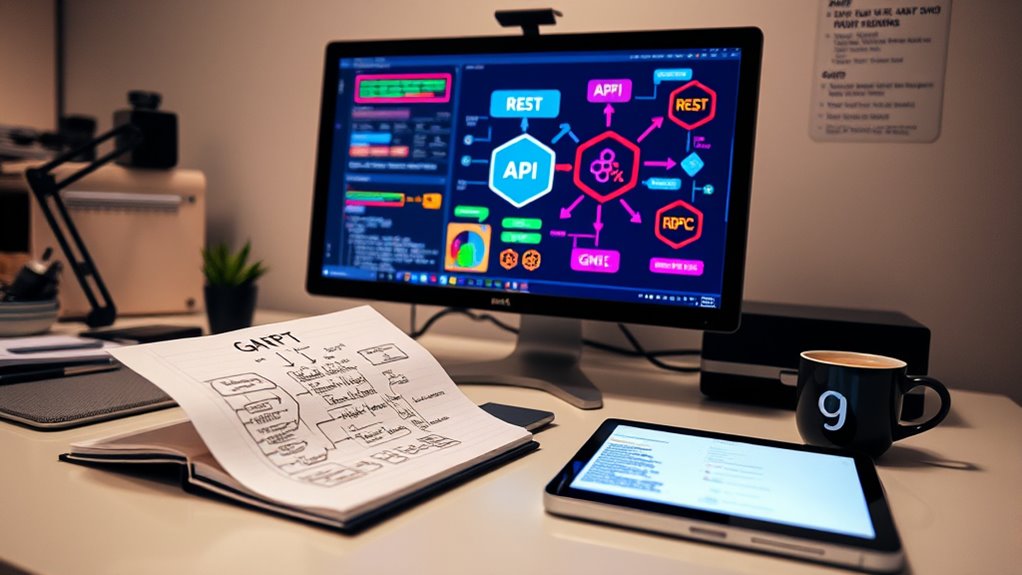When designing APIs, you should consider core principles like consistency, security, and versioning. REST is simple and stateless, using standard HTTP methods ideal for broad compatibility. GraphQL offers flexibility, letting clients specify data needs to reduce over-fetching. gRPC delivers high performance with Protocol Buffers, suitable for scalable systems. Choosing the right paradigm depends on your security and throughput requirements. Stick around, and you’ll discover how to apply these principles effectively to your projects.
Key Takeaways
- REST emphasizes simplicity, statelessness, and standard HTTP methods, ideal for scalable, easy-to-maintain APIs.
- GraphQL allows clients to specify precise data needs, reducing over-fetching and improving efficiency.
- gRPC uses Protocol Buffers for high-performance, low-latency communication suitable for microservices and real-time apps.
- REST is best for public APIs with broad compatibility; GraphQL offers flexibility for complex client requirements; gRPC excels in high-throughput environments.
- Choosing among REST, GraphQL, and gRPC depends on scalability, data complexity, real-time needs, and development ecosystem considerations.

Designing effective APIs begins with understanding the core principles that guarantee they are easy to use, reliable, and scalable. One of the fundamental aspects to focus on is API versioning. Without a clear versioning strategy, you risk breaking existing clients when making updates or adding new features. You should plan ahead for how your API will evolve, whether through URL versioning, header-based versioning, or other methods. This way, you provide a consistent experience for developers, allowing them to migrate smoothly without disruption. Alongside versioning, security best practices are essential to protect your API and its users. Implementing authentication and authorization mechanisms such as OAuth 2.0 or API keys helps control access, while HTTPS encrypts data in transit to prevent interception. Regularly updating security protocols and monitoring for vulnerabilities also keep your API safe from potential threats. Additionally, understanding API design principles can help guide you in creating more effective interfaces that meet user needs.
When designing your API, consider the principles of REST, GraphQL, and gRPC, each offering unique advantages. REST emphasizes simplicity and stateless interactions, making it suitable for broad compatibility and ease of use. Properly designed RESTful APIs should follow conventions like using standard HTTP methods and status codes, which improves clarity and reduces confusion for developers. GraphQL, on the other hand, offers flexible data retrieval by allowing clients to specify exactly what they need, reducing over-fetching and under-fetching issues. This makes it ideal for complex applications requiring dynamic data. gRPC provides high-performance communication through Protocol Buffers, making it suitable for microservices and real-time systems. When choosing between these paradigms, consider your application’s specific needs, such as scalability, ease of maintenance, and security.
Security best practices extend beyond basic authentication. You should also implement rate limiting to prevent abuse, validate all inputs to mitigate injection attacks, and ensure proper error handling to avoid exposing sensitive information. For API versioning, you might embed version info in your endpoints or use headers, but whichever method you choose, document it clearly for consumers. This transparency helps developers understand how to interact with your API over time. Additionally, adopting a consistent approach to versioning and security across your API ensures that integrations remain stable, and updates don’t introduce unforeseen vulnerabilities.
Frequently Asked Questions
How Do I Choose the Best API Protocol for My Project?
To choose the best API protocol, consider your project’s API scalability and developer experience. If you need simple, scalable solutions with wide support, REST is a good choice. For flexible data retrieval and complex queries, GraphQL offers a better developer experience. If your project demands high performance and real-time communication, gRPC might be ideal. Match the protocol’s strengths with your project’s specific needs to make the best decision.
What Are Common Pitfalls in API Versioning Strategies?
You should watch out for common pitfalls like breaking backward compatibility, which can disrupt existing clients, and causing versioning conflicts that confuse users. It’s tempting to add new features without proper versioning, but this risks breaking older clients. Always plan a clear versioning strategy, communicate changes upfront, and guarantee smooth transitions to prevent these issues. This helps maintain trust and keeps your API reliable for all users.
How Does Security Differ Across REST, Graphql, and Grpc?
You’ll find that security varies across these protocols. REST often uses authentication methods like OAuth and data encryption via HTTPS. GraphQL also relies on OAuth and HTTPS but needs careful query validation to prevent data leaks. gRPC emphasizes strong data encryption with TLS and supports authentication methods like token-based or mutual TLS. Overall, securing each requires implementing proper authentication methods and ensuring data encryption to protect sensitive information effectively.
Can These API Types Be Combined in a Single Project?
Absolutely, you can combine these API types in a single project. By blending REST, GraphQL, and gRPC, you’ll benefit from diverse data demands and protocol compatibility. This integration allows you to leverage their unique strengths—REST’s simplicity, GraphQL’s flexibility, and gRPC’s speed—creating a thorough, cohesive, and capable API ecosystem. Just guarantee smooth API integration and clear protocol compatibility to keep everything running seamlessly and securely.
What Are the Performance Considerations for Each API Style?
You should consider that REST offers simplicity but may face scalability challenges under high loads, affecting performance. GraphQL reduces over-fetching, improving latency, but can introduce complexity, impacting scalability. gRPC provides low latency and high throughput, ideal for real-time applications, but might struggle with scalability across diverse clients. Balancing these factors helps optimize performance, ensuring your API handles growth efficiently while minimizing latency issues.
Conclusion
Choosing the right API design depends on your needs—whether you prioritize simplicity, flexibility, or performance. REST, GraphQL, and gRPC each have strengths and trade-offs, so understanding your application’s requirements is key. Don’t you want to build a seamless, efficient experience for your users? By applying these principles thoughtfully, you’ll create APIs that are not only effective today but also adaptable for tomorrow’s challenges.








